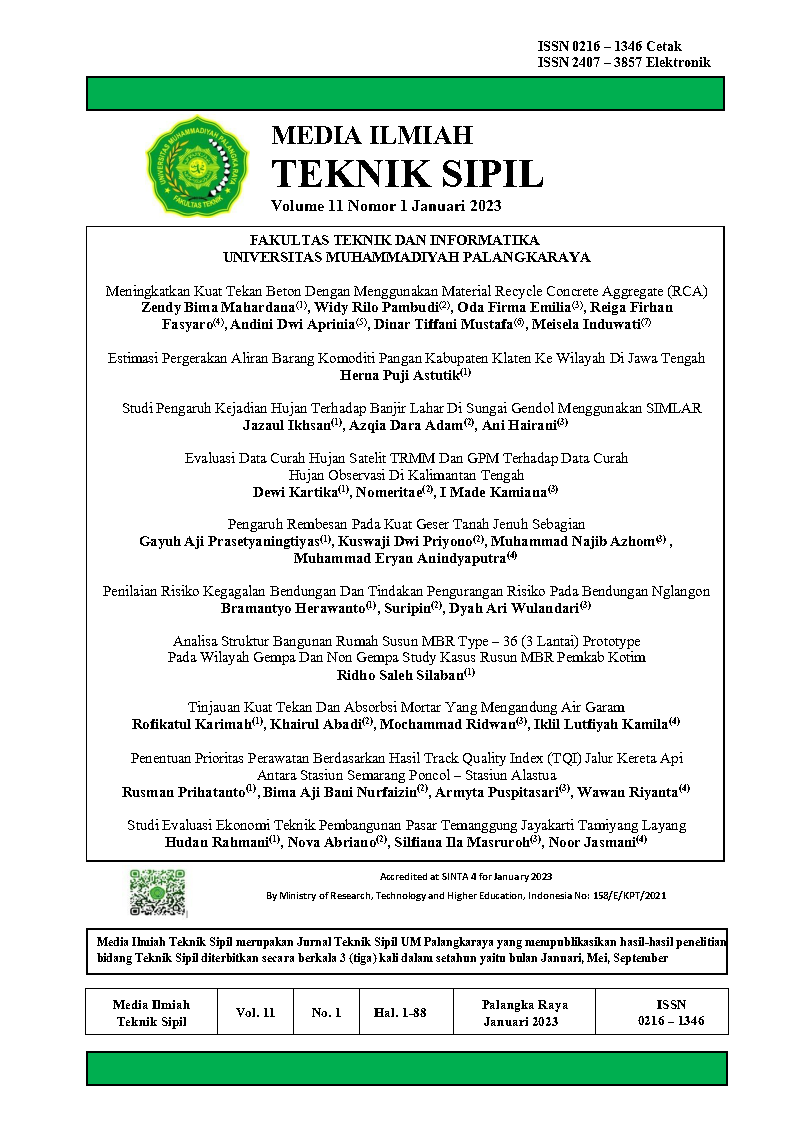Tinjauan Kuat Tekan Dan Absorbsi Mortar Yang Mengandung Air Garam Review Of The Compressive Strength And Absorbtion Of Mortars Containing Baline
Main Article Content
Abstract
Mortar is a building material that serves to glue bricks, bricks, plaster, and so on. As an adhesive, mortar has a viscosity that is useful in determining compressive strength. In the manufacture of mortar, SNI 03-6882-2002 requires the use of clean fresh water, but in reality, as an archipelagic country, some of the islands in Indonesia are isolated from fresh water. As a result, freshwater becomes an expensive item, because it is imported from other areas, so it requires transportation costs. If the mortar is required to use water according to SNI standards, the project implementation costs will be expensive. In areas that do not have adequate fresh water, mortar is made using water obtained on-site, including brackish, salt, and sea water. Seawater contains elements of NaCl salts which can bind Calcium Hydroxide (CaOH) compounds, reducing the CaOH compounds in the mortar will increase the compressive strength of the mortar. In this study, a review of brine as a mixture of mortar materials was carried out with the aim of knowing the performance of mortar containing salt water by compressive strength test and Absorption test. The amount of salt water added to the mortar mixture is 0%; 0.5%; 1%; 1.5%; 2%; 2.5% ; 3%; 3.5% of the volume of water used as a mortar mix. Cube test object measuring 50x50x50 mm3 in the amount of 5 in each treatment, made from a mixture of 1PC: 2.75 Sand (based on weight ratio), with a water-cement factor (FAS) of 0.45. The test results obtained the compressive strength value of the mortar with the addition of salt water can reduce the compressive strength value but the use of brine with a content of 3.5% is still in the category of minimum permissible pressure according to SNI03-6882-2002. While the absorption value of the mortar can increase fiber strength with increasing addition of 3.0% brine.
Downloads
Article Details

This work is licensed under a Creative Commons Attribution-ShareAlike 4.0 International License.
All rights reserved. This publication may be reproduced, stored in a retrieval system, or transmitted in any form or by any means, electronic, mechanical, photocopying, recording.
References
Erniati, dkk. 2017. “KONSISTENSI DAN KUAT TEKAN MORTAR YANG MENGGUNAKAN AIR LAUT SEBAGAI MIXING WATER” dalam Jurnal Konferensi Nasional Teknik Sipil 7, Makassar.
Husin,Andriati Amir, 2016, “Pengaruh Larutan Garam Sulfat Terhadap Kualitas Beton Ringan” Jurnal Pemukiman, Vol. 5 No. 2. Bandung.
Mulyono, T. 2003. Teknologi Beton. Yogyakarta. Andi Publishing.
Pratiwi,Kingkin Dwi dkk, 2019, “Kuat Tekan dan Porositas Mortar Serbuk Karet PadaSuhu Tinggi” Jurnal Rekayasa Sipil (JRS-UNAND). Sumatra Barat.
Rulian,Nizar Farhan, Priyanto Saelan. 2020, ”Kajian Batasan Nilai FAS Pada Campuran Beton di Lingkungan Korosif” Jurnal Teknik Sipil. ITB Bandung.
Sari,Neri Puspita dkk. 2017. “Kuat Tekan dan Porositas Mortar Dengan Bahan Tambah Gula Aren, Prosiding Konferensi Nasional Teknik Sipil dan Perencanaan (KN-TSP)”. Pekanbaru.
Sidiq,Fajar Abdul,Eko Walujodjati, 2021, “Meninjau Kekuatan Tekan Beton Pada Lingkungan Air Laut Pamaengpek Kabupaten Garut” Jurnal Konstruksi, Volume 19 No. 1. Jawa Barat.
Tjokrodimulyo Kardiyono, 1992, “Pengetahuan Dasar Teknologi Beton”, Universitas Gajah Mada, Yogyakarta.
Tata,Arbian,2019. “SIFAT MEKANIS BETON DENGAN CAMPURAN PASIR PANTAI DAN AIR LAUT” Jurnal Ilmu Pengetahuan dan Teknologi Sipil, Volume 3, No. 1. Maluku Utara.
